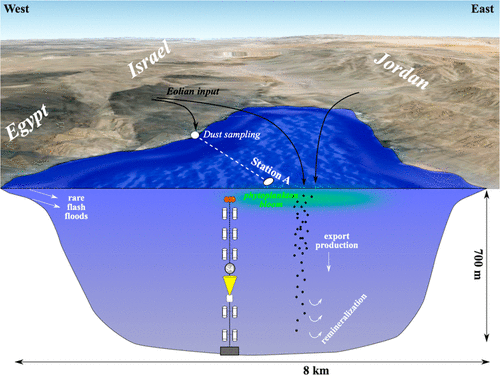当前位置:
X-MOL 学术
›
ACS Earth Space Chem.
›
论文详情
Our official English website, www.x-mol.net, welcomes your
feedback! (Note: you will need to create a separate account there.)
Bulk and Export Production Fluxes in the Gulf of Aqaba, Northern Red Sea
ACS Earth and Space Chemistry ( IF 2.9 ) Pub Date : 2020-06-24 , DOI: 10.1021/acsearthspacechem.0c00079 Adi Torfstein 1, 2 , Stephanie S. Kienast 3 , Barak Yarden 2 , Asaph Rivlin 2 , Shuki Isaacs 2 , Yonathan Shaked 2
ACS Earth and Space Chemistry ( IF 2.9 ) Pub Date : 2020-06-24 , DOI: 10.1021/acsearthspacechem.0c00079 Adi Torfstein 1, 2 , Stephanie S. Kienast 3 , Barak Yarden 2 , Asaph Rivlin 2 , Shuki Isaacs 2 , Yonathan Shaked 2
Affiliation

|
Marine particulate fluxes were studied between 2014 and 2017 in the oligotrophic Gulf of Aqaba (GOA), northern Red Sea. A bottom tethered mooring mounted with 5 sediment trap stations (KC Denmark Inc.) at approximately equal depth intervals between 120 and 570 m (water depth of ∼610 m) was rotated monthly. The bulk particulate fluxes were determined for the entire period, with organic C and N, CaCO3, and lithogenic fluxes determined for the first two and half years of the deployment. The results are evaluated in the context of monthly resolved records of seawater temperature, chlorophyll-a concentrations, and macro-nutrient concentrations, as well as hourly to weekly dust load records and rare fluvial events. The results are further compared to core-tops collected from varying water depths and are combined to produce a basin source-to-sink mass balance of particulate fluxes. The GOA undergoes strong seasonal changes expressed by surface water temperatures and water column stratification and mixing, which control the vertical and temporal distribution of nutrients and primary and export production. Accordingly, the seasonal variability in particulate fluxes varies over a wide range, typically displaying peak bulk fluxes in bottom waters during the winter (∼5–7 g m–2 d–1) and minimum values in shallow waters during summer (<0.5 g m–2 d–1). Organic C and N fluxes are the highest in shallow waters and display strong vertical attenuation that varies seasonally, a-priori reflecting enhanced remineralization in the warm shallow waters during summer. In contrast, particulate organic carbon and nitrogen fluxes are enhanced in bottom waters during winter, due to the combined effect of the increased presence of mineral ballasts and vertical water column mixing. The quantification of particulate fluxes in the GOA suggests that, while most of the bulk particulates are introduced into the basin via episodic fluvial events, with direct dust inputs contributing approximately an order of magnitude less material, the internal cycling of terrigenous material is complex, with a lag between the initial deposition of influxing material along shallow margins and seasonal reworking and transport of sediments to the deep seafloor. Nevertheless, the fluxes of terrigenous and organic particulates are largely independent of each other, with export production fluxes driven by water column mixing and nutrient availability in the photic zone. In addition to being the first quantitative report of bulk and export production fluxes in the region, our results provide an improved understanding of the interplay between export production and terrigenous fluxes as well as an interpretation of the paleo-record in the GOA and in comparable environments. On a wider scale, the findings reported here relate to the role of dust deposition and hemipelagic sedimentation in the oceans and their impact on export production and particle cycling in coastal regions. Combined, these findings illuminate the factors impacting marine habitats and ecosystems, the cycling and sequestration of trace elements and anthropogenic components in the oceans, and facilitate better understanding of the interplay between solid and dissolved phases in the oceans and reconstructing past oceanographic and climatic conditions from marine sediment cores.
中文翻译:

北部红海亚喀巴湾的散装和出口生产通量
在2014年至2017年之间,对红海北部亚营养化的亚喀巴湾(GOA)的海洋颗粒通量进行了研究。每月旋转一次底部系留的系泊设备,该系泊设备安装有5个沉积物捕集站(KC丹麦公司),深度间隔大约相等,介于120至570 m(水深约610 m)之间。确定了整个时期的总体颗粒通量,并在部署的前两年和后半年确定了有机碳和氮,CaCO 3以及成岩通量。在每月解析的海水温度,叶绿素a记录的背景下评估结果浓度和大量营养物浓度,以及每小时至每周的粉尘负荷记录和罕见的河流事件。将结果进一步与从不同水深处收集的岩心顶相比较,并将其组合起来,以形成盆状颗粒物通量从源头到汇的质量平衡。GOA经历了由地表水温度和水柱分层和混合所表现出的强烈的季节性变化,这些变化控制着养分的垂直和时间分布以及初级和出口生产。因此,颗粒通量的季节性变化在很大范围内变化,通常在冬季(〜5–7 gm –2 d –1)的底水中显示峰值散装通量,而在夏季(<0.5 gm – 2天–1)。有机碳,氮通量最高在浅水中,并显示强的垂直衰减是改变季节性,先验反映出夏季温暖的浅水区中的再矿化作用增强。相反,由于矿物压载物增加和垂直水柱混合的综合作用,冬季底水中的有机碳和氮颗粒通量增加。GOA中颗粒物通量的量化表明,尽管大多数散装颗粒物是通过间歇性河流事件引入盆地的,但直接的粉尘输入减少了大约一个数量级的物质,而陆源物质的内部循环却很复杂,沿浅层边缘的入流物质的初始沉积与沉积物的季节性返工和向深海底的运输之间的时间差。不过,陆源和有机微粒的通量在很大程度上彼此独立,水柱混合和光合作用区养分的可利用性带动了出口生产通量。除了成为该地区第一份关于大宗和出口生产通量的定量报告外,我们的结果还使人们对出口生产和陆源通量之间的相互作用有了更好的了解,并解释了GOA和可比环境中的古记录。 。从更广泛的角度来看,这里报道的发现涉及海洋中粉尘沉积和半海岸沉积的作用及其对沿海地区出口生产和颗粒循环的影响。综合起来,这些发现阐明了影响海洋栖息地和生态系统的因素,海洋中微量元素和人为成分的循环和固存,
更新日期:2020-08-20
中文翻译:

北部红海亚喀巴湾的散装和出口生产通量
在2014年至2017年之间,对红海北部亚营养化的亚喀巴湾(GOA)的海洋颗粒通量进行了研究。每月旋转一次底部系留的系泊设备,该系泊设备安装有5个沉积物捕集站(KC丹麦公司),深度间隔大约相等,介于120至570 m(水深约610 m)之间。确定了整个时期的总体颗粒通量,并在部署的前两年和后半年确定了有机碳和氮,CaCO 3以及成岩通量。在每月解析的海水温度,叶绿素a记录的背景下评估结果浓度和大量营养物浓度,以及每小时至每周的粉尘负荷记录和罕见的河流事件。将结果进一步与从不同水深处收集的岩心顶相比较,并将其组合起来,以形成盆状颗粒物通量从源头到汇的质量平衡。GOA经历了由地表水温度和水柱分层和混合所表现出的强烈的季节性变化,这些变化控制着养分的垂直和时间分布以及初级和出口生产。因此,颗粒通量的季节性变化在很大范围内变化,通常在冬季(〜5–7 gm –2 d –1)的底水中显示峰值散装通量,而在夏季(<0.5 gm – 2天–1)。有机碳,氮通量最高在浅水中,并显示强的垂直衰减是改变季节性,先验反映出夏季温暖的浅水区中的再矿化作用增强。相反,由于矿物压载物增加和垂直水柱混合的综合作用,冬季底水中的有机碳和氮颗粒通量增加。GOA中颗粒物通量的量化表明,尽管大多数散装颗粒物是通过间歇性河流事件引入盆地的,但直接的粉尘输入减少了大约一个数量级的物质,而陆源物质的内部循环却很复杂,沿浅层边缘的入流物质的初始沉积与沉积物的季节性返工和向深海底的运输之间的时间差。不过,陆源和有机微粒的通量在很大程度上彼此独立,水柱混合和光合作用区养分的可利用性带动了出口生产通量。除了成为该地区第一份关于大宗和出口生产通量的定量报告外,我们的结果还使人们对出口生产和陆源通量之间的相互作用有了更好的了解,并解释了GOA和可比环境中的古记录。 。从更广泛的角度来看,这里报道的发现涉及海洋中粉尘沉积和半海岸沉积的作用及其对沿海地区出口生产和颗粒循环的影响。综合起来,这些发现阐明了影响海洋栖息地和生态系统的因素,海洋中微量元素和人为成分的循环和固存,











































 京公网安备 11010802027423号
京公网安备 11010802027423号